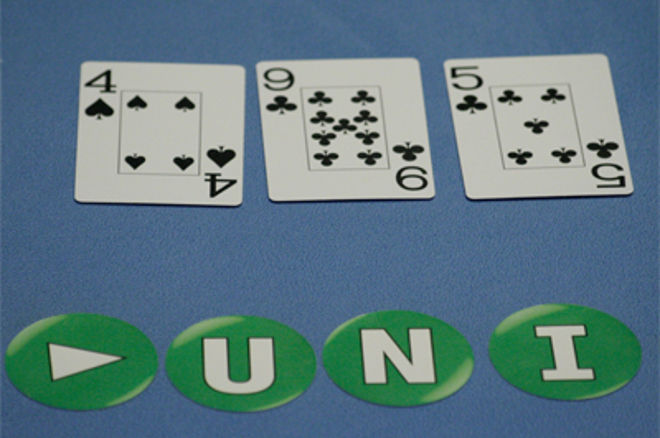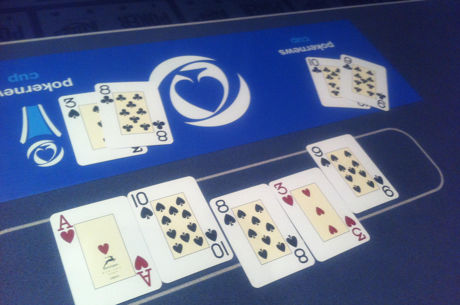How to Use Partial Outs in Hold��em to Avoid Overvaluing Hands

The term ��outs�� in Texas hold��em refers to the number of cards that will help you make the best hand when drawing. Learning how to calculate outs is often among the first type of ��poker math�� absorbed by new hold��em players. Whether by trial and error through playing or by reading through strategy articles or books, players soon commit to memory the outs needed for commonly faced draws.
For example, on the turn the board shows 10?A?2?K? and you hold 6?5?. Knowing there are 13 hearts in the deck and being able to see four of them �� two on the board, and two in your hand �� it��s easy enough to figure out there are nine more hearts potentially left to make your heart flush and (presumably) what figures to be the best hand.
Most players are able to keep in mind ��flush draw = 9 outs�� and use that knowledge to help determine whether or not it is worth staying in a hand. Here are some of the more common situations for which it��s good to know off the top of your head how many outs will complete a draw:
| Type of Draw | Outs |
|---|---|
| inside straight draw | 4 |
| have one pair, drawing to two pair or trips | 5 |
| drawing to one pair with two overcards | 6 |
| open-ended straight draw | 8 |
| flush draw | 9 |
| flush draw + inside straight draw | 12 |
| flush draw + two overs (that would make top pair) | 15 |
| flush draw + open-ended straight draw | 15 |
Knowing that nine cards will complete your flush and also knowing that there are 46 unseen cards gives you an idea of the percentage chance that a heart will come on the river �� about 19.6% or just under 4-to-1.
That in turn should help you decide, say, whether or not to call when there is 2,400 in the pot and your opponent makes a full pot-sized bet of 2,400. That��s 2-to-1 pot odds, and with it being a little less than 4-to-1 to hit your draw, that��s probably too much to pay (unless you��re sure about implied pot odds giving you the chance to win considerably more should you make your flush).
Let��s set aside the odds talk, though, and look again at those nine outs you have. Or do you?
Recognizing ��Partial Outs��
While most players are good at figuring out how many cards complete draws for them to help them make desired hands, many aren��t so careful when it comes to recognizing that some of those ��outs�� may in fact not be outs at all. In some cases, what seems like an ��out�� for you could also improve an opponent��s hand enough to keep the other player in front.
There��s a tendency affecting many players to be overly optimistic about their chances of winning and be too ��generous�� with themselves regarding just how many cards might improve them to the best hand. Or (more often) to be a little loose with the math to favor calling over folding in situations when they really shouldn��t.
One way to keep yourself in check regarding your actual chances of drawing to a better hand is not to discount the possibility that one or more the outs you��re counting might in fact not help you win the hand. It is here that the concept of ��partial outs�� is worth keeping in mind.
Take the example described above �� you have 6?5? and the board is showing 10?A?2?K?, giving you that flush draw. And, apparently, nine outs to win.
Let��s say the preflop action and what happened on the flop and turn is suggesting the strong possibility that AxAx, KxKx, 10x10x, and AxKx are all part of your opponent��s narrow range of hands. Say he��s a tight player who three-bet for the first time all day, then fired both postflop streets in ways that suggested by that point he had at least two pair or perhaps a set.
If he indeed had AxKx, one combo �� A?K? �� would be bad news for you, as not only is he in front with two pair, he��s also drawing to a better flush. In that case he��d also have two of those hearts you��re seeking in his hand, removing them from your remaining outs.
If he has AxAx, that would mean K? isn��t an out for you anymore, as it would make a full house (and A? would mean quads). Similarly, if he has KxKx, the A? on the river makes him a full house (and K? quads). Meanwhile with 10x10x either the A? or K? would give you a flush while again improving him to a better hand.
In other words, if he does have any of these hands you think could well be part of his range, either the A? or K? becomes a questionable river card for you.
These may sound in theory like unlikely possibilities, especially if you are like most players and want to be ��optimistic�� that you can��t possibly lose should you complete that flush. But when drawing to a small flush there��s always going to be some chance an opponent has a bigger one, and a board-pairing card that completes your flush should also always give you pause.
In fact, whenever you are drawing to something less than the absolute nuts �� as in this example �� you should be ready to think of at least some of your outs as being ��partial outs�� that reduce your overall chances of improving to the best hand.
��Partial Outs��: A Practical Application
We could with our example introduce some complicated math and calculate down to a certain fraction just how many ��partial outs�� there are among the nine. To do that, we��d assess the chances your opponent had each one of those hands thought to be among his range above, come up with an overall percentage, then multiply it by nine to estimate your actual outs.
A more practical approach would simply be to make a collective estimate of the chances your opponent has a hand like two pair or a set that would make a couple of your outs no good. Let��s say you decide there��s a 50% chance he has a hand that would make either a A? or K? river no good for you. Each of those outs, then, could be considered a half of an out, thus reducing your nine ��true�� outs down to eight.
That doesn��t figure in that smaller chance he��s holding A?K? which would make all hearts non-outs for you, but if you wanted to do so we could and reduce our ��true�� outs even further down to 7.5 or 7.
In many cases, recognizing ��partial outs�� isn��t going to affect your decision-making too much. If he��s betting the pot on the turn here, giving you 2-to-1 pot odds to call, the fact that you have 9 or 8 or 7 outs isn��t going to matter much �� it��s not going to be a good call to make, regardless.
But say he only bets half the pot �� 1,200 into 2,400 �� giving you 3-to-1 to call. Thinking optimistically, you might have been eager to call that with what you assumed was about a 4-to-1 chance to make your flush. (20% isn��t that far from 25%, you��re thinking... and oh yeah, implied odds!)
Figure in ��partial outs,�� though, and you��re actually down to a little over 15% or worse than 5-to-1 to make a winning hand. Just taking that extra step before acting might help you see a little more clearly it��s still going to be a loose call.
Conclusion
Being aware of ��partial outs�� or the possibility that not all of your apparent outs are ��true�� outs helps you avoid overvaluing your drawing hands. It needn��t involve a lot of complicated math, but can be used to shave off an out or two, helping you make more informed postflop decisions.
Want to stay atop all the latest in the poker world? If so, make sure to get PokerNews updates on your social media outlets. Follow us on Twitter and find us on both Facebook and Google+!









